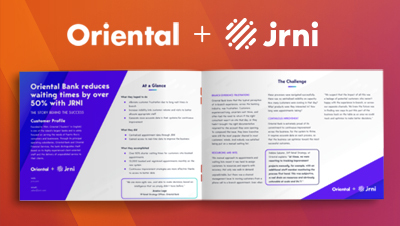In less than a decade, Oriental Bank has had a meteoric rise in the Puerto Rican banking space. In fact, since introducing digital transformation initiatives in 2013, they’ve risen from 9th to the 3rd largest financial services provider in Puerto Rico. While other banks are closing their branches left and right, Oriental has found success by sticking to one of their core principles: delivering superior customer service.
As a part of their digital transformation, Oriental either develops technology in-house or turns to best of breed providers (like JRNI!)
Oriental’s partnership with JRNI began earlier in 2016 after deciding to implement an appointment scheduling solution across their branches. Now, customers can now use the bank’s site or mobile app to make appointments at the time and branch of their choice, scheduling meetings with product and service specialists. When customers do schedule an appointment, their waiting times have dropped by over 50%.
With plenty of appointment data to back up the results, Jessica Lugo and Debbie Sabater, VP and SVP of Oriental’s Retail Strategy team offered more insights into the project.
JRNI: Talk me through your recent work on customer experience at Oriental Bank
OB: It all started with us looking closely at the customer experience and how well we delivered on the promises of our brand. Our brand promise to the market is that we are different, and so a lot of work goes into making sure that comes true across all our channels.
We started with branches, where we still see a large volume of customer interactions. It became clear that wait times and lines were still a frustration for customers, especially if they didn’t know how long they might have to wait.
In some cases, they might have come in to open something like a new account, waited for their turn, only to find that they didn’t have the proper documentation. This story will come as no surprise to anyone who has been on either side of a bank experience.
JRNI: How far did these challenges extend into how you were able to run the business?
OB: We found there was also an “in-branch traffic” management challenge. It was an unreliable and manual process to assign customers to resources with accuracy based on need. Or to move them from phone inquiries to the branch or back.
We couldn’t always see visibility of capacity around these matters -- for example, how many customers were coming in each day? For what reason? How long was each type of meeting taking?
Further to this, we run a process of continuous improvement in our team, always challenging ourselves to use data to learn what’s working and optimize towards it. Without these signals, a lot of time was spent manually reviewing and monitoring new processes -- so as to be able to calculate “we invested in X, and the results were Y.”
JRNI: And what do you think was the crucial impact of all this?
OB: Ultimately, because of this experience, we lost potential customers – and potential revenue with it.
Across the management side, we also had to acknowledge an unavoidable increased cost of inefficiency. Overcapacity in branches meant idle resources. Not being able to make decisions on real resourcing data added further cost.
JRNI: Now, how did you tackle these challenges?
OB: Ultimately, the more we looked at it, the more our research pointed us toward a booking and appointment platform that would truly unite our online and offline channels.
Because of their broad experience with projects like ours, we felt confident in JRNI's ability to deliver a solution that would work in the real world. The project management support we received made the process run smoothly, and we were up and running as planned.
JRNI has indeed helped us both in allowing customers to proactive arrange their visits to our branches, and also better manage in-branch walk-in traffic through the “walk-in” solution that allowed us to holistically simplify bookings and walk-ins, while providing a more accurate and transparent time expectation to customers as they arrived, thus a better customer experience.
As far as statistics, booking solution adoption rates are still very low, as we haven’t made much “noise” about it yet, ensuring proper internal adoption and usage.
Nevertheless, we managed over 20,000 in-branch customers through JRNI, again allowing us for a better customer flow and proactive handle. Furthermore, tracking this inflow by time slots has provided us the proper intelligence and insight to better equip with personnel our branches and capitalize on idle hours and be more efficient on our operations.
JRNI: What’s your overall philosophy regarding the perfect customer experience?
OB: As we touched on at the start of this conversation, it’s where the customer perceives our brand as accessible, convenient, and innovative.
If you asked them what their experience was with us, we want them to say one of those list of characteristics. And we want to make banking easy for our customers and do what they want, wherever they are.
The benefits we have obtained from this project have helped us look farther into the future. It has sparked us a vision of things we would like to do more.
To do it right, you should think about how you alter your processes so the technology (which has been thoroughly tested and used by many) is more useful.
I think there’s a balance there. Rather than trying to fit the tech into your current way of doing things, you should look to the experts that have thought through that process and built more efficient technology.
Want to continue learning about Oriental Bank’s digital transformation with JRNI? Download the case study here.




